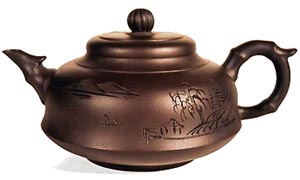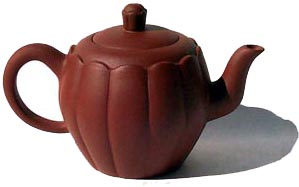| Yixing
A traditional Chinese Teapot
 Yixing
teapots come from Jiangsu province in China, where they
have been hand
made for many centuries. While they have been made since
the Sung Dynasty (960-1279 AD), their production flourished during
the Ming Dynasty (1368-1643 AD). It was around this time that Yixing
teapots also became popular in Europe. Yixing
teapots come from Jiangsu province in China, where they
have been hand
made for many centuries. While they have been made since
the Sung Dynasty (960-1279 AD), their production flourished during
the Ming Dynasty (1368-1643 AD). It was around this time that Yixing
teapots also became popular in Europe.
 Yixing
teapots are typically made from a locally found clay called "zisha",
which means 'purple clay'. Sometimes other colored clays, such as
ochre or blue are used. The unglazed, slightly porous interior surface
is suitable for bringing out the flavor of the tea and the insides
are traditionally never scoured or cleaned with detergent, but only
rinsed with hot water. Often, it is even recommended to use only
one type of tea for a pot, thus preserving the flavor characteristics
that the clay takes on. Yixing
teapots are typically made from a locally found clay called "zisha",
which means 'purple clay'. Sometimes other colored clays, such as
ochre or blue are used. The unglazed, slightly porous interior surface
is suitable for bringing out the flavor of the tea and the insides
are traditionally never scoured or cleaned with detergent, but only
rinsed with hot water. Often, it is even recommended to use only
one type of tea for a pot, thus preserving the flavor characteristics
that the clay takes on.
Today, Yixing teapots is as prized in the West as
much as in the East, and Western potters such as Geo Lastomirsky,
Ah Leon, Jon Neely and others find inspiration in their timeless
beauty.
More Articles
More on Teapots
More Pots of the Week
|